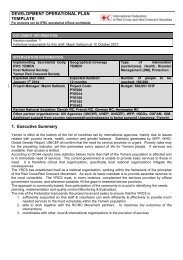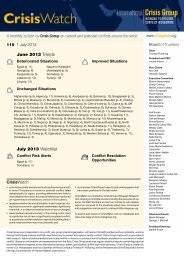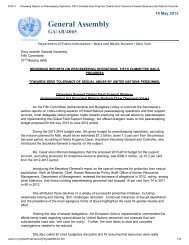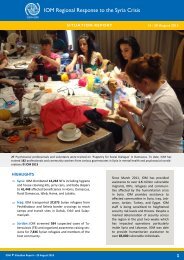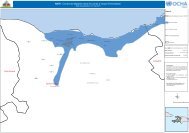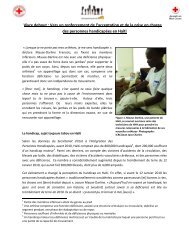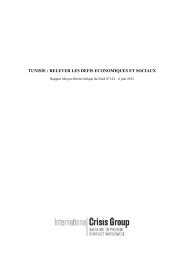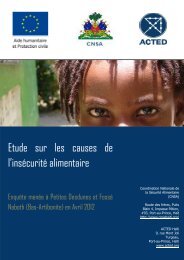SOMALI NUTRITION STRATEGY 2011 – 2013 - ReliefWeb
SOMALI NUTRITION STRATEGY 2011 – 2013 - ReliefWeb
SOMALI NUTRITION STRATEGY 2011 – 2013 - ReliefWeb
You also want an ePaper? Increase the reach of your titles
YUMPU automatically turns print PDFs into web optimized ePapers that Google loves.
52<br />
Only just over half of households (55%) report that soap in the household was used for washing<br />
hands in one or more of the given situations (MICS 2006). The lack of clean water, poor hygiene<br />
and environmental sanitation are major causes of diseases in particular diarrhoeal diseases and<br />
cholera. Diarrhoeal diseases are the cause of 19% of deaths of children under five. According to<br />
MICS 2006, only 7% of children with diarrhoea receive appropriate treatment (ORS and continued<br />
feeding). Preliminary results from the FSNAU meta-analysis 2001-2008 indicate that diarrhoea is<br />
a significant predictor of acute malnutrition. The paradox is that the water and sanitation situation<br />
are major underlying cause of morbidity and malnutrition in Somalia, yet interventions have been<br />
relatively poorly funded.<br />
The relationship between malnutrition and morbidity is well established. Disease outbreaks have<br />
shown to have a significant effect on malnutrition rates in Somalia. In Lower and Middle Juba<br />
regions, since March 2009 an outbreak of acute watery diarrhoea across all livelihoods coincided<br />
with a significant deterioration in the nutrition situation to Very Critical despite improvements<br />
seen in food security indicators in the region. In Shabelle and Juba, high rates of malnutrition<br />
were attributed to high incidence of acute watery diarrhoea and acute respiratory tract infections<br />
(FSNAU Post Gu 2009 assessment).<br />
3.4 Education<br />
The UNICEF conceptual model highlights inadequate education as one of the basic causes of<br />
malnutrition. According to UNICEF, only 24% of women are literate, while 20% of girls attend<br />
school. Overall 23% of children (25% of boys and 21% of girls) of primary school age attend<br />
primary school, (44% urban, 12% rural). For every 10 boys attending primary school, there are<br />
8 girls, while for secondary school, for every 10 boys attending, only 5 girls. A large number of<br />
secondary school age children attend primary school due to lack of schooling opportunities that<br />
followed the overthrow of Siad Biarre in 1991 and the social chaos.<br />
While each of these groups of underlying causes has been discussed independently of each<br />
other, there is a clear inter-connectedness between them. Underlying causes are overlapping<br />
and have a synergistic effect so that the combined effects of a failure of all three causes are<br />
much greater than the sum of their parts. This is the foundation of the need for an integrated,<br />
multi sectoral response. As discussed, different causes differ in their significance for the different<br />
regions and livelihoods. For example in urban populations, dietary diversity is much better than<br />
for the rural populations, and sub optimal care practices such as use of breast milk substitutes<br />
may be more significant in the explanation of malnutrition.<br />
4. Current Nutrition Interventions<br />
In response to persistently high rates of acute malnutrition, current nutrition interventions have<br />
been focused on saving lives through the management of acute nutrition.<br />
4.1 Nutrition Cluster<br />
Due to weak governance structures in parts of Somalia, nutrition response programming is mainly<br />
undertaken by UN, international and national agencies. The Nutrition Working Group (NWG) was<br />
initiated in 1995 to coordinate nutrition related issues. In 2006, as part of the UN Humanitarian<br />
Reform, the cluster approach was introduced. From the start this was integrated into the existing<br />
NWG. Thus the Nutrition Cluster and NWG exist as a single coordination structure, referred to<br />
as the Nutrition Cluster, for nutrition activities in Somalia. The primary purpose of the Nutrition<br />
Cluster is “to support and strengthen a coordinated approach in nutrition strategic planning,<br />
situation analysis and response both in emergencies and non-emergency situations.” (Nutrition<br />
Cluster TORs Dec 2009). There are currently 79 members of the Nutrition Cluster including local<br />
and international NGOS and UN agencies working in the field of nutrition in Somalia.




